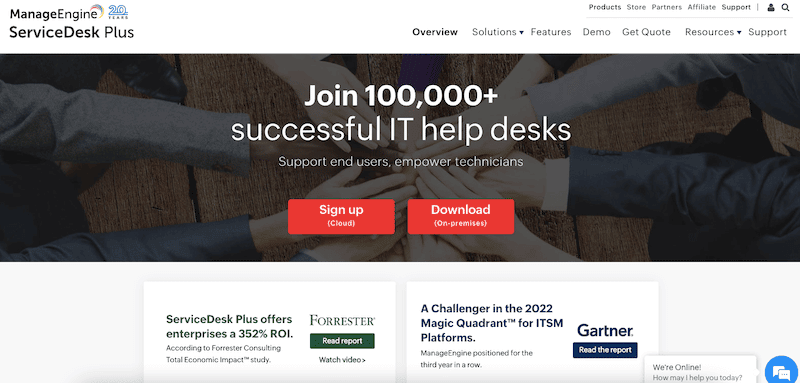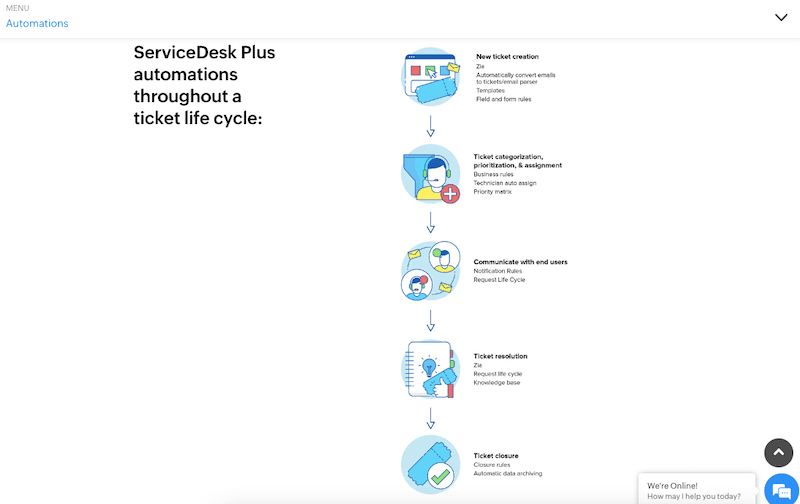We may earn a commission if you make a purchase through the links on our website.
ManageEngine ServiceDesk Plus Review
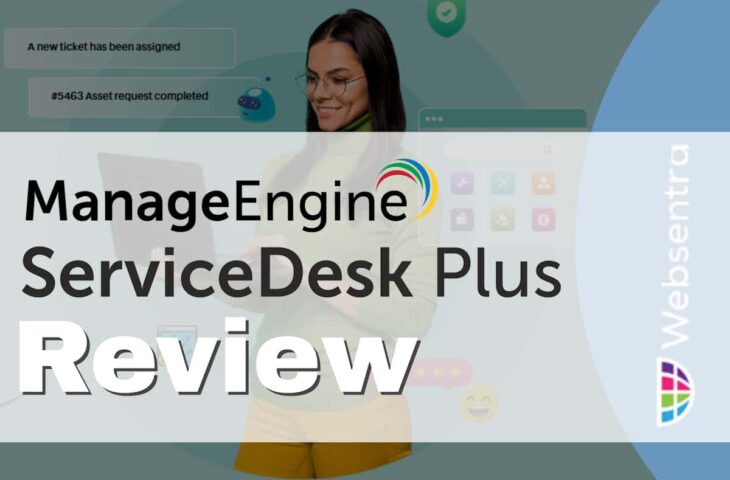
UPDATED: May 29, 2024
Without the right tools and strategies, IT help desk teams will struggle to keep up and may find themselves in a constant state of “fire-fighting”. Attempting to solve every IT issue, as it comes from every direction, will overwhelm any IT help desk team. Plus, IT end-users, such as employees and contractors, will get frustrated and waste valuable productive time waiting for their company-based software or hardware issues to be resolved.
ManageEngine ServiceDesk Plus – a robust IT help desk and asset management software, can help IT teams address these issues more effectively and provide better support to end users.
In this ManageEngine ServiceDesk Plus review, we will go through the basics of what the software is, what it can do for your team, its core features, its editions, pricing, and customer support. In the last section, we will briefly discuss the differences between the cloud and on-premises versions and what you need to start with each.
Table of Contents
- What is ManageEngine ServiceDesk Plus?
- ManageEngine ServiceDesk Plus features in detail
- ITSM workflows
- Integrations with IT management applications
- Automate Service Desk Operations
- Extensive reporting capabilities
- Codeless customizations
- ManageEngine ServiceDesk Plus Editions, Licensing, and Pricing
- ManageEngine ServiceDesk Plus Customer Support
- Starting with ManageEngine ServiceDesk Plus
- Final Words
1. What is ManageEngine ServiceDesk Plus?
ManageEngine ServiceDesk Plus (also known as SDP) is a robust help desk and IT asset management solution that streamlines the management and resolution of IT service requests. It includes a range of features designed to help IT desk teams track and resolve support issues, manage IT assets, and improve the efficiency of IT support operations.
ServiceDesk Plus also provides fantastic visibility and control when dealing with IT issues. With it, the IT help desk can keep track of an organization’s demands and proactively allocate resources to the right user (or department) needing the most resources. ManageEngine ServiceDesk Plus has been labeled as “A Challenger” in Gartner’s 2022 Magic Quadrant for ITSM platforms. It has been in the same position for three years in a row.
a. ManageEngine ServiceDesk deployment options
ManageEngine ServiceDesk Plus is available via two different deployment versions: cloud-based or on-premises installation.
- The cloud-based solution is a fully managed version of the software, hosted, running on the cloud, and based on a subscription. The SDP’s cloud version is designed for high performance, stability, and reliability and is regularly upgraded to the latest version without user intervention.
- ManageEngine ServiceDesk Plus is also available via on-premises server installation. This solution must be installed on a self-hosted and self-managed server. The on-premises edition is paid annually (including support).
b. Who would need ManageEngine ServiceDesk Plus?
Any company looking for a help desk to manage its own IT infrastructure resources would benefit from using ServiceDesk Plus. IT departments, including help desk agents, systems, and IT managers, can use ManageEngine ServiceDesk Plus (SDP) to manage and monitor the company’s internal IT infrastructure. These teams can also use SDP to manage and monitor IT support queries from users directly related to the company, such as employees or subcontractors.
c. What is not ManageEngine ServiceDesk Plus?
SDP is an excellent fit for those organizations wanting to build a help desk to manage their own IT infrastructure. Still, it is not appropriate for companies like MSPs to control and monitor their resources and other companies being served. In addition, SDP is not suitable for companies selling products and needs specific software that helps with support queries explicitly related to the product being sold. For those two needs, ManageEngine offers ManageEngine ServiceDesk Plus MSP (more aligned to an ITSM solution and explicitly tailored to Managed Service Providers) and ManageEngine Support Center Plus (SCP- where configurations relate to business units or a product being sold).
2. ManageEngine ServiceDesk Plus Features in Detail
a. ITSM Workflows
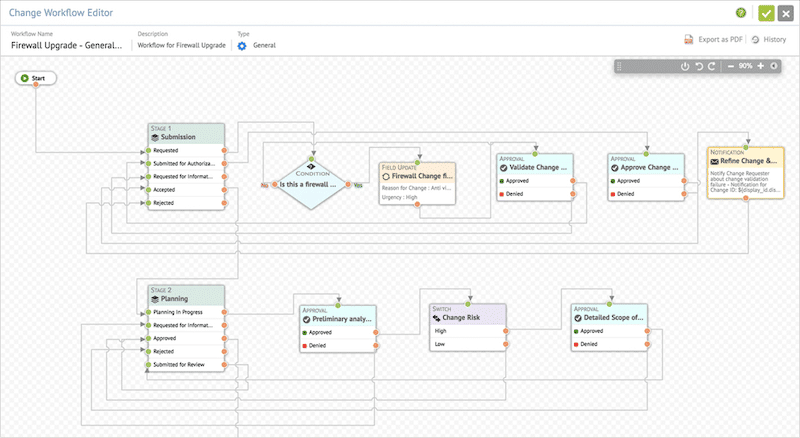
ServiceDesk Plus comes with a change workflow editor/builder that allows you to visualize and automate many service delivery processes. You can design process plans and execute them immediately and change implementations anytime on the go with dynamic change workflows. ServiceDesk Plus includes a drag-and-drop canvas, eight custom stages and statuses, and the ability to add actions across the entire change lifecycle, including notifications, conditions, switches, field updates, approvals, and more. Additionally, you can create custom change templates and link them with change workflows to handle any type or size of change. ServiceDesk Plus also allows you to define change roles and configure permissions for users to view, edit, and approve changes throughout the entire change lifecycle.
b. Integrations with IT Management Applications
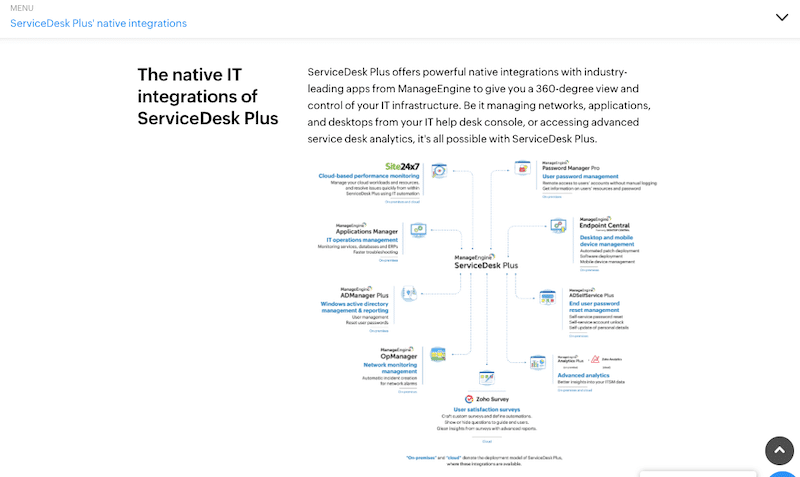
Integrating different components of an IT environment with the service desk is an essential process for getting real-time visibility and control of the entire IT infrastructure. Channeling all these components through the service desk allows admins to categorize, prioritize, and assign them accordingly.
ServiceDesk Plus can be extended through integrations with other products and third-party applications.
It provides native integrations with ManageEngine apps to get an entire view and control of the IT infrastructure. These applications include (Zoho’s) ManageEngine’s Password Manager Pro, Desktop Central, Site24x7, Applications Manager, ADManager Plus, ADSelfService Plus, OPManager, Analytics Plus, and Zoho Survey. But that is not all; ServiceDesk Plus also provides integrations to other third-party business tools with your service desk; these include Office 365 actionable messages, Jira, MS Outlook, Office 365 Calendar, MS Teams, Zoho Cliq, and Zoho Voice.
c. Automate Service Desk Operations
ServiceDesk Plus introduces smart automation for multiple service desk tasks, including new ticket creation, ticket assignment, prioritizations and categorizations, ticket resolution and closure, and notifications. With ServiceDesk Plus’ automation capabilities, organizations can also provide multi-channel support with the help of Zia – a conversational AI-based chatbot to help you with basic ticket functions, smart knowledge base suggestions, automated notifications, and feedback collection. Other automation features include business rules, technician auto-assignment, automatic notifications, and SLA management.
Automating service desk operations allows the IT help desk to improve customer experience and optimize IT environments. It helps reduce human-made errors (with RLC and mandatory fields), costs, and turnaround times.
d. Extensive Reporting Capabilities
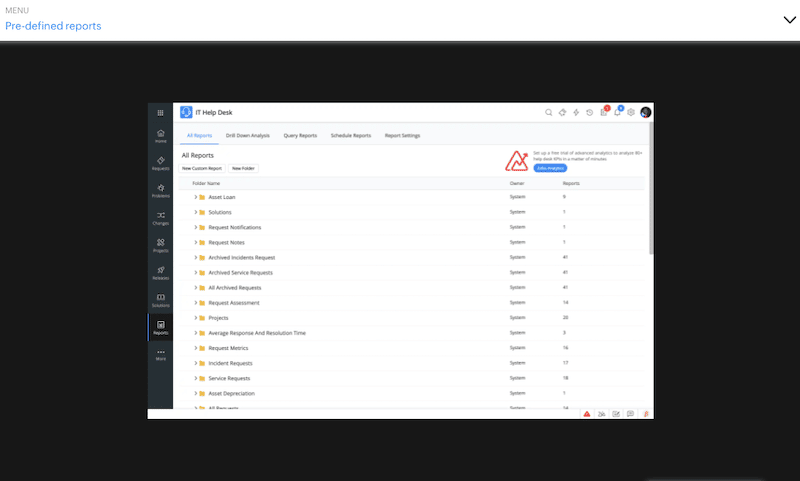
ManageEngine ServiceDesk Plus includes a range of reporting capabilities that allow users to track and analyze data related to IT service requests, assets, and other aspects of IT service management. ManageEngine ServiceDesk Plus includes powerful reporting features such as:
- Custom report builder A reporting feature that allows users to create custom reports based on various data points and filters.
- Predefined reports SDP includes a range of predefined reports that provide insights into various aspects of IT service management, such as incident trends, asset utilization, and more.
- Dashboards The software includes a variety of dashboards that provide real-time visibility into key performance indicators (KPIs) and other data points.
- Scheduled reports Users can schedule reports to be delivered automatically at regular intervals, such as daily, weekly, or monthly.
- Export to CSV or PDF Reports can be exported in various formats, including CSV and PDF, for easy sharing and analysis.
e. Codeless Customizations
ManageEngine ServiceDesk Plus includes a range of features and tools that allow users to customize the software without writing code. This makes it easier to tailor the software to the specific needs of their organization. For instance, users can create custom fields (without coding) to store and track additional data points related to IT service requests, assets, and other elements of IT service management. Another example of SDP’s customizations includes the workflow designer tool, which allows users to customize the process of managing and resolving IT service requests, including defining rules and triggers for automatic actions.
Other popular codeless customizations include email templates (control the format and content of emails sent by the software), Knowledge base (create and manage a knowledge base of articles and other content to help support users), and asset management (set of tools for managing and tracking IT assets, including custom fields and workflows.)
3. ManageEngine ServiceDesk Plus Editions, Pricing, and Modules
ManageEngine ServiceDesk Plus is available as a cloud-based or on-premises software. Both versions have similar capabilities, with key differences in integrations, system requirements, and pricing. Plus, both can be obtained through different licensing models. A ManageEngine ServiceDesk Plus license allows an organization to use the software for a specific period and includes access to all features, customer support, and updates. Licenses are typically purchased per technician per year, with volume discounts available for larger organizations. Prices will vary depending on the software edition and the number of technicians using it.
ManageEngine ServiceDesk Plus is available in a range of editions to meet the needs of different organizations.
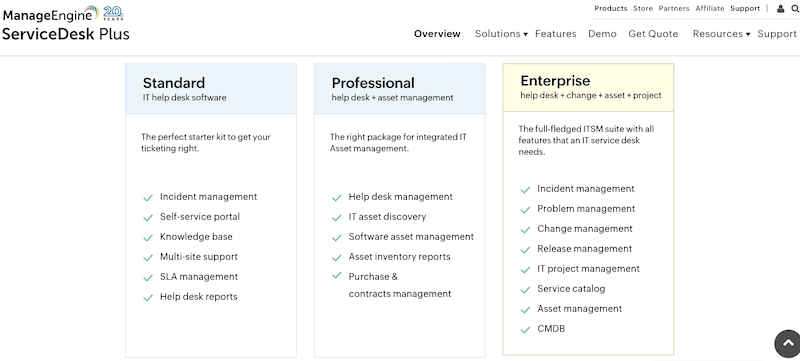
- Standard (IT Help Desk) SDP’s Standard edition is the entry-level version of the software. It includes basic features for incident management and comes with a self-service portal, help desk reports, multi-site support, and other IT Help Desk fundamentals.
- Professional (IT Help Desk + asset management) SDP’s Professional edition includes all the Standard edition’s features and additional capabilities such as help desk management. The professional edition is designed for integrated IT asset management. It provides integration with third-party tools and advanced reporting.
- Enterprise (Help Desk + asset + change + project) The Enterprise edition includes all the features of the Professional edition, as well as additional capabilities such as integration with ITIL, advanced change, problem and release management, as well as support for multiple organizations.
Each edition of ManageEngine ServiceDesk Plus is designed to meet the needs of different types and sizes of organizations. The Standard edition is suitable for small organizations, while the Enterprise edition is for larger organizations with more complex IT service management needs.
a. Pricing
Overall, ManageEngine ServiceDesk Plus is a relatively reasonably priced IT service desk and asset management software with a range of editions to meet the needs of different organizations.
The pricing for ManageEngine ServiceDesk Plus will vary according to the software version (cloud or on-premises), the edition (standard, professional, or enterprise), and the license type. Prices on every edition are generally quoted per technician per year, and discounts are available for multi-year licenses and volume purchases.
Note: The prices displayed on this ManageEngine Service PlusDesk Review do not include any discounts that may be available at the moment and are always subject to change.
Here’s the approximate pricing for the ManageEngine ServiceDesk Plus (cloud-based) editions:
- Standard Starts at $10 per technician/month
- Professional Starts at $21 per technician/month
- Enterprise Starts at $50 per technician/month
Here’s the approximate pricing for the ManageEngine ServiceDesk Plus (on-premises-based) editions:
- Standard $120 per technician/year
- Professional $248 per technician/year
- Enterprise $598 per technician/year
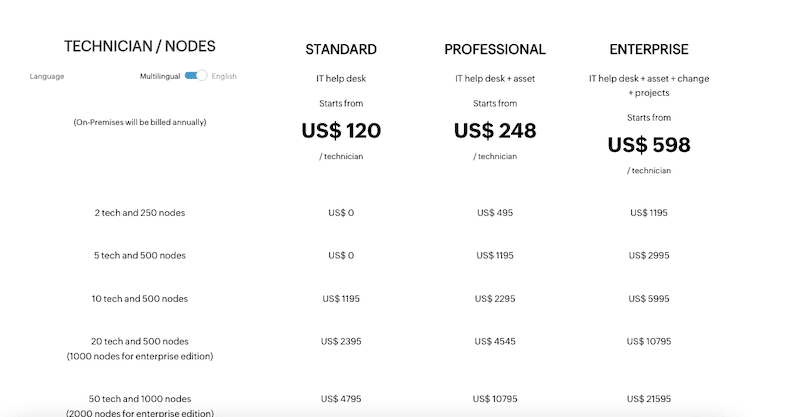
b. ManageEngine ServiceDesk Plus Complimentary Modules
ManageEngine ServiceDesk Plus is a comprehensive service desk solution that includes a good number of modules for asset management, knowledge management, project management, SLA management, survey management, and ITIL process management. These modules help you manage different aspects of your IT infrastructure and support operations, including tracking and managing assets, creating and maintaining a knowledge base, managing IT projects, defining and tracking SLAs, gathering customer feedback, and following ITIL best practices.
The pricing for each module may vary depending on the number of users and the features included. For instance, AssetExplorer starts at $1,995 for 25 users, and IT360 begins at $3,995 for 25 users.
4. ManageEngine ServiceDesk Plus Customer Support
ManageEngine offers three levels of support for contacting the ManageEngine in-house experts: Free, Classic, and Premium. Free support includes access to online resources such as a knowledge base, forums, and how-to guides, as well as the ability to request technical assistance from the ServiceDesk Plus support team for minor issues.
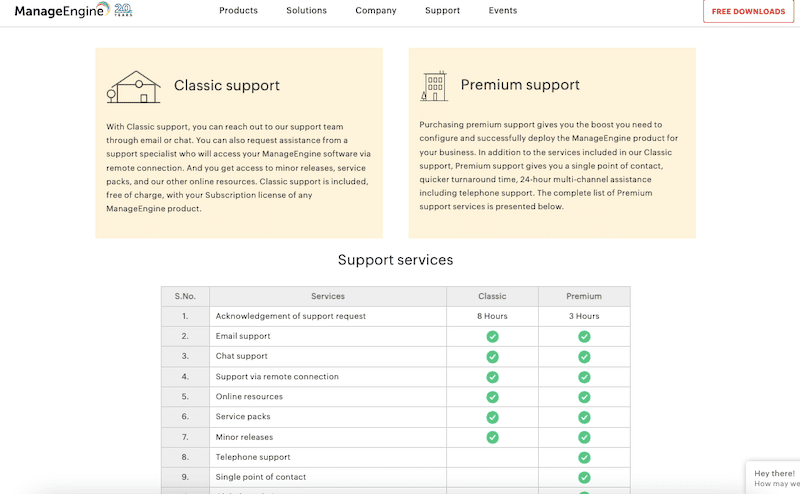
Classic support, included at no additional cost with a ManageEngine ServiceDesk subscription, includes email and chat support, access to online resources, and the option to connect with experts for guidance. Premium support, also available at an additional cost, includes all the features of Classic support, plus faster responses, 24/7 assistance, and telephone support. To learn more about ManageEngine Service Desk Plus support plans and pricing, contact the sales team at sales@manageengine.com.
ManageEngine includes various customer technical support options to help users get the most out of the software. Some critical customer support options available with ManageEngine ServiceDesk Plus plans include:
- Documentation ManageEngine ServiceDesk Plus includes a range of online documentation and guides to help users learn about the software and troubleshoot issues.
- Training ManageEngine also offers various training options, including online courses, instructor-led training, and even customized training, to help users get up to speed with the software.
- Community ManageEngine has an active online community where users can ask questions, share tips, and best practices, and get help from other users and experts. Access to this community is free.
- Support portal ManageEngine provides a support portal where users can submit and track support tickets, access a knowledge base, and download software updates.
- Phone and email support ManageEngine offers telephone and email support for users with more complex issues or questions.
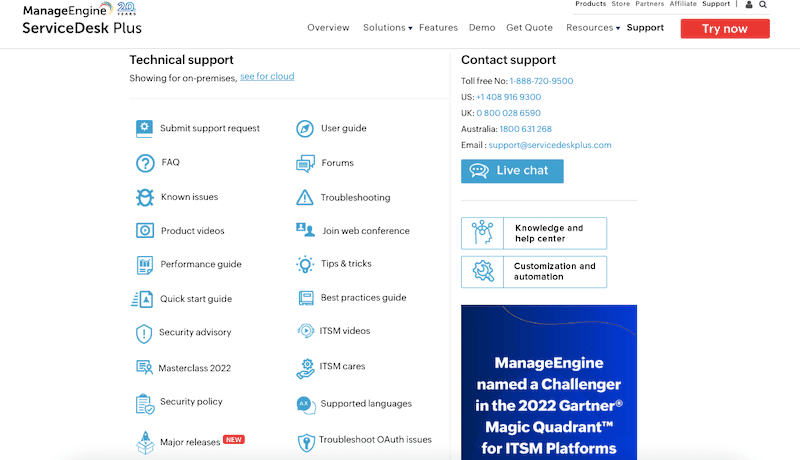
5. Starting with ManageEngine ServiceDesk Plus
As mentioned in the previous sections, you can start with ManageEngine ServiceDesk Plus by running the fully-hosted (SaaS-based) cloud-based version of the software or installing the software on your premises. Signing up for a free trial of the Service Desk Plus cloud-based version would be the easiest and most convenient way to test the waters with ManageEngine ServiceDesk Plus.
The system requirements for ManageEngine ServiceDesk Plus depend on the version of the software you are using and the type of installation you are performing (either on-premises or cloud).
a. What Do You Need to Start with the On-premises Software?
Here are the general “minimum” system requirements for a typical on-premises installation of ManageEngine ServiceDesk Plus:
- Operating system Windows Server 2012 R2, 2016, 2019, or 2022. Linux, RHEL 8 or above, Ubuntu 14.0 or above, CentOS OS 8 (SE).
- Processor The recommended is 4 cores to 8 cores or any entry-level server-grade processor—1.7GHz or higher (depending on the daily inbound requests).
- Memory 16 GB RAM minimum recommended.
- Hard disk 2 GB free space is the minimum recommended for installation. SSD Hard disk type recommended with 500 GB for additional data storage space.
- Database Microsoft SQL Server 2012, 2014, 2016, 2017, or 2019. In addition, PostgreSQL (applicable to ServiceDesk Plus version 10.0 and earlier) is bundled with the installation (if needed.)
- Browser An updated version of the following web browsers is recommended: Microsoft Edge, Google Chrome, or Mozilla Firefox.
Note: If you decide to run the on-premises ServiceDesk Plus version, you’ll need to host it on your servers. A benefit of an on-premises deployment is that it gives you complete control and access to the database. However, your organization is responsible for maintaining the security and privacy of user data and ensuring the ServiceDesk software’s reliability. In addition, keep in mind that you may require more RAM space and better processors when the load increases.
b. What Do You Need to Start with Cloud Software?
The hosting company (ManageEngine) installs and maintains the ServiceDesk Plus cloud-based server, so your system requirements for running ManageEngine ServiceDesk Plus are different. You only need a standard and secure web browser to access the web interface. Customization of the server may be limited, but the hosting company offers on-demand customizations within specific parameters.
c. What are the steps to start with ManageEngine ServiceDesk Plus?
During installation, you'll need to set up the database. The application requires access to a database to store and retrieve data. This can be a local database or hosted on a separate server.
Once installed, both server and database, you'll need to configure ManageEngine ServiceDesk Plus with the following general steps:
- Configure the application Begin configuring the application to meet your specific needs; this may include setting up users and groups, creating custom fields and forms, and configuring email and notification settings.
- Import data If you are migrating from another service desk application, you will need to import your existing data into ServiceDesk Plus. Various tools and methods are available for importing data, such as CSV files or database import/export utilities.
- Integrate with other systems If you want to combine ServiceDesk Plus with other systems, such as your organization's CRM or HR systems, you will need to perform integrations. This may involve configuring API connections or using integration tools provided by ManageEngine or third-party vendors.
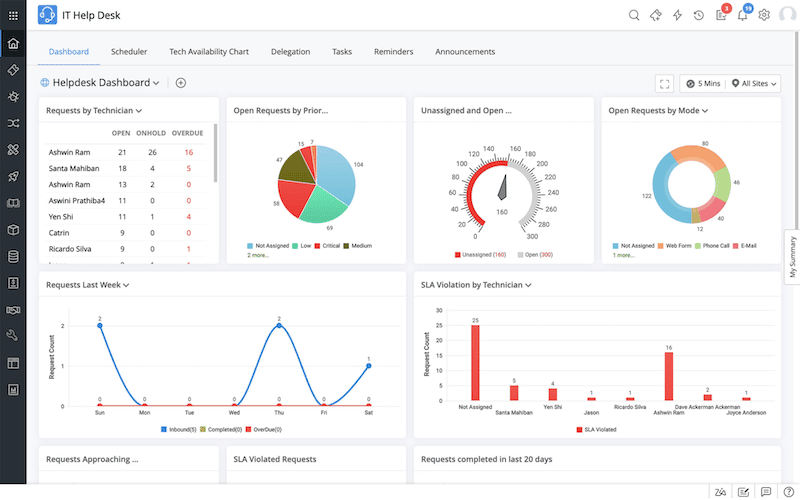
6. Final Words
ManageEngine ServiceDesk Plus (SDP) is a web-based IT service management (ITSM) and IT Help Desk software designed to help you streamline your IT and support processes. The software is known for being a quite comprehensive ITSM solution, giving you various benefits, including a highly customizable, scalable, and integrable solution.
Although it is a fantastic solution, SDP has a few drawbacks; one is its price, which can be more expensive than some of its competitors, especially for smaller organizations. In addition, ServiceDesk Plus is also quite comprehensive, with a wide range of features, which can be overwhelming for many. So, it may not be the best choice for organizations looking for a more basic or budget-friendly option.
But overall, ManageEngine ServiceDesk Plus is a highly competitive ITSM and customer service software. And the majority of IT help teams are pretty happy with the product. To test the waters yourself, try ManageEngine ServiceDesk Plus's free trial of the cloud or on-premises.
